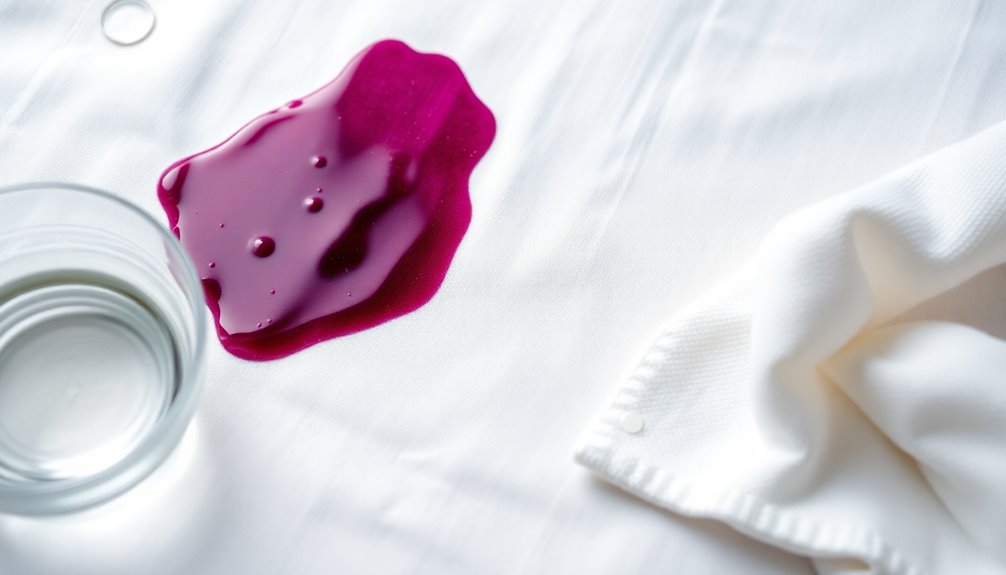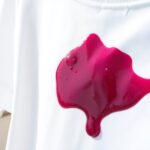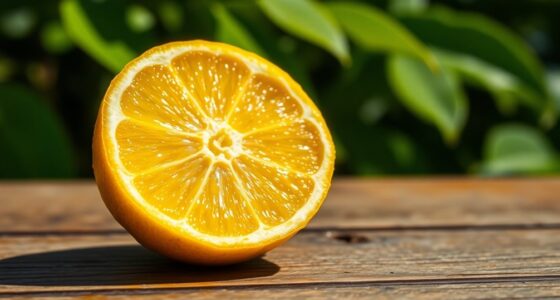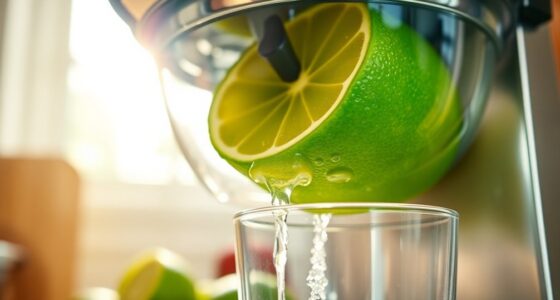To get grape juice stain out, act fast! Blot the stain with a cloth, rinsing it under cold water from behind. Next, mix dish soap and white vinegar, applying it to the stain and letting it sit for 15-30 minutes. Wash the fabric in cold water with quality detergent, and check for any remaining stain before drying. If it's still there, try a hydrogen peroxide and dish soap mixture. There are even more tips to help you tackle stubborn stains!
Key Takeaways
- Act quickly by blotting the stain with a clean cloth to absorb excess grape juice without rubbing it in.
- Rinse the stained area under cold running water from behind to help push the juice out and prevent setting.
- Pre-treat the stain with a mixture of dish soap and white vinegar, letting it sit for 15-30 minutes before rinsing.
- Wash the garment in cold water with quality laundry detergent, checking for stain removal before drying.
- For stubborn stains, apply a mixture of hydrogen peroxide and dish soap, allowing it to sit briefly before rinsing again.
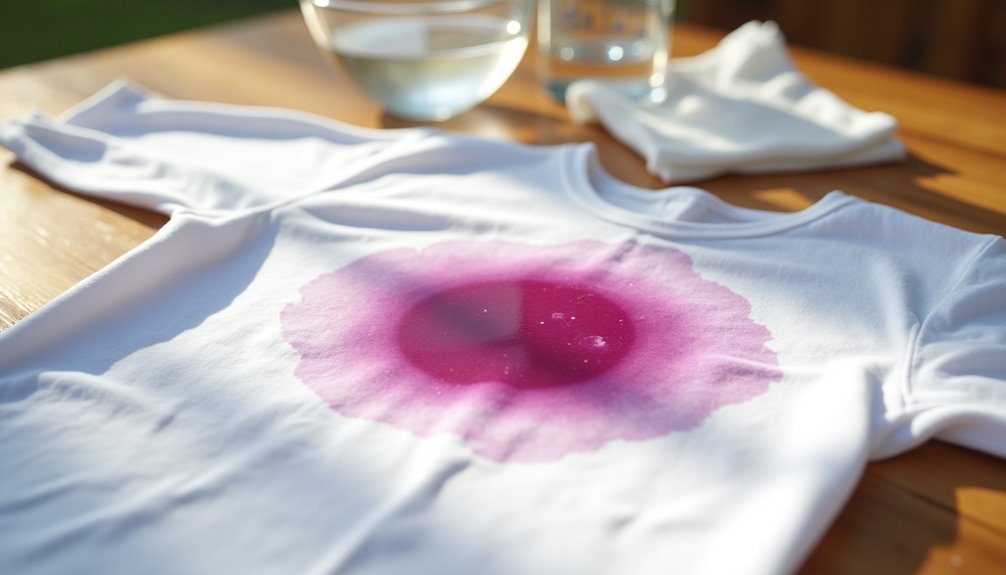
Grape juice stains can be a real headache, but acting quickly can save your favorite shirt or tablecloth. As soon as you notice that vibrant purple mark, you need to jump into action. The key to successfully removing a grape juice stain lies in how swiftly you respond.
Grab a clean cloth or paper towel and start blotting the stain gently. Blotting helps absorb the excess liquid and prevents the stain from setting deeper into the fabric. Remember, rubbing it can make things worse, so stick to blotting.
After you've blotted up as much of the grape juice as possible, it's time for a cold water rinse. Take the stained fabric and hold it under cold running water. Make sure you're flushing the fabric from behind, which will help dilute the juice and push it out rather than further into the fibers. Cold water is crucial here; it keeps the stain from setting, which can happen with warm or hot water.
Next up, you'll want to pre-treat the stain. You have a couple of options for this. A simple and effective cleaning solution can be made by mixing dish soap and white vinegar. Apply this mixture directly onto the stain and let it sit for about 15-30 minutes.
This pre-treatment is essential as it breaks down the grape juice's pigments, making them easier to remove. If you prefer, you could also use a dedicated stain remover that's designed for tougher stains.
Once pre-treatment time is up, it's time to wash the garment. Use a quality laundry detergent and make sure to launder in cold water. It's critical to check that the stain is completely gone before putting the fabric in the dryer. Heat from the dryer can set the stain permanently, making it nearly impossible to remove afterward.
If you still see traces of the stain, don't toss it in the dryer just yet.
For those stubborn grape juice stains that refuse to budge, a more potent combination can help. Mix hydrogen peroxide with dish soap and apply it directly to the stain. Allow it to sit for a few minutes, and then rinse with cold water.
If the stain persists, don't hesitate to repeat this treatment until you see successful results.
With these steps, you can effectively remove grape juice stains from your clothes or tablecloths. Quick action and the right cleaning solutions are your best allies in the battle against those pesky stains.
Frequently Asked Questions
Will Grape Juice Stains Come Out?
Yes, grape juice stains can come out if you act quickly.
You'll want to rinse the stained area with cold water right away. Pre-treat it with a stain remover for the best results.
If the stain has dried, don't worry—you can still tackle it with solutions like hydrogen peroxide and dish soap.
Just remember, avoid using heat until the stain's completely gone, or you risk setting it permanently in the fabric.
Does Hydrogen Peroxide Remove Grape Juice Stains?
Think of hydrogen peroxide as your trusty sidekick in the battle against grape juice stains.
Yes, it can effectively remove those pesky marks thanks to its bleaching properties. When you mix it with dish soap, you're enhancing its stain-fighting powers.
Just apply the solution directly to the stain, let it sit for 15 minutes, then rinse with cold water.
Remember to test it on a small area first to avoid any surprises!
How Do You Get Juice Stains Out of Fabric?
To get juice stains out of fabric, start by blotting the area with a clean cloth to absorb excess liquid.
Rinse the stained spot under cold running water, pushing from the back to flush the stain out.
Next, pre-treat it with a mix of dish soap and white vinegar, letting it sit for 15-30 minutes.
Finally, wash the fabric in the hottest safe water, and check for any remaining stains before drying.
How to Remove Grapes Stains?
Removing grape stains can feel like battling a fierce dragon, but you've got this!
Start by quickly blotting the stain with a clean cloth to absorb as much juice as possible. Rinse the area under cold water from the back, then pre-treat with dish soap and vinegar. Let it sit for about 15-30 minutes, then rinse again.
For stubborn stains, hydrogen peroxide and dish soap can work wonders. Always check before drying!
Conclusion
So, you thought grape juice was just a tasty treat? Ironically, it can turn into a pesky stain that seems to have a mind of its own! But don't fret—getting rid of it isn't as hard as it seems. With the right techniques, you can reclaim your clothes and surfaces from the clutches of this vibrant liquid. Next time you pour that glass, just remember: what goes down smoothly can sometimes leave a messy reminder behind!
Cindy thoroughly researches juicing trends, techniques, and recipes to provide readers with practical advice and inspiration. Her writing style is accessible, engaging, and designed to make complex concepts easy to understand. Cindy’s dedication to promoting the advantages of juicing shines through her work, empowering readers to make positive changes in their lives through the simple act of juicing.

